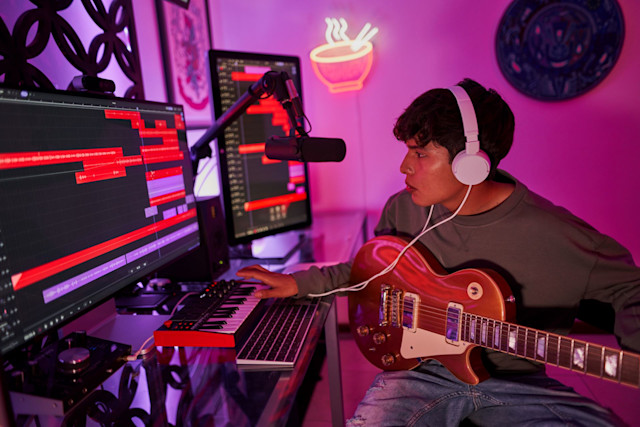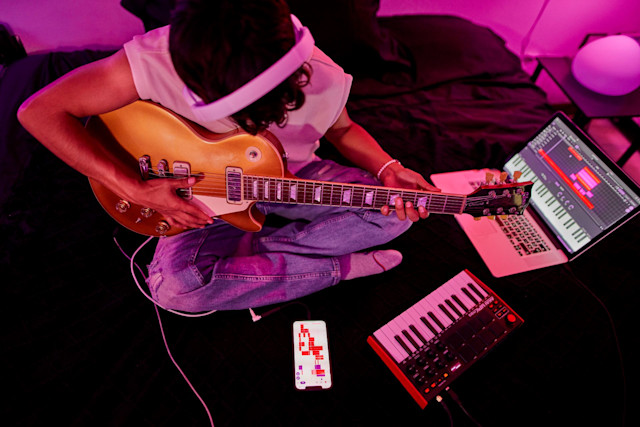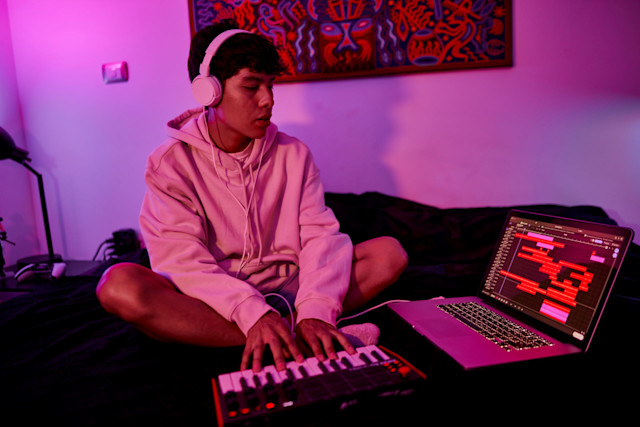Recording equipment needed to make beats
November 22, 2024 - Discover the basic and essential equipment to start producing professional quality beats.

When starting out making beats, one of the most common questions for many producers is, “What equipment do I really need?” The choice is vast, and it's often confusing to know whether investing in expensive gear or sticking with more affordable options is the best decision.
With so much advice floating around the industry, from the latest technology to classic tools that seem like must-haves, defining a clear direction becomes essential for any producer.
It's important to note that, nowadays, you can start making music without any additional equipment. Thanks to technological advances, today it is possible to create beats using only a computer and even from your cell phone.
There are incredibly powerful DAWs and mobile apps that allow you to produce music with amazing quality, which opens the door to all those who want to start without a large investment. Creativity and mastery of digital tools can take you far, no matter the size of your setup.
In this article, we'll look at everything from the most affordable and versatile hardware options to the high-end equipment that inspires those looking for professional quality. We'll also talk about how to get the most out of each piece of gear, something that top producers value over any investment, especially when starting out in a home studio.
1. Define your style and space: the first step in any gear decision
The first factor to consider before buying gear is your own production style. What kind of beats do you want to make, do you see yourself recording vocals or live instruments, or do you lean more towards digital creation with no external elements? These questions will guide you in choosing what you need.
Added to this is the importance of space. If you're working in a small or medium-sized space with basic acoustic treatment, investing in large studio monitors or an extremely sensitive microphone may not be the best idea to start with. In this case, you could focus on tools that suit your environment, optimizing each purchase according to your recording conditions.

2. The Heart of your Production: Computer and DAW
If there are two essential elements to produce beats, they are the computer and the DAW (Digital Audio Workstation). Although you don't need a state-of-the-art machine, it is important that your equipment has certain basic features to avoid technical problems during production.
Minimum Recommended Features:
Processor: Intel Core i5 or AMD Ryzen 5 minimum to handle plugins and virtual instruments.
RAM: 8 GB for basic projects; 16 GB if you plan to use heavier libraries.
Storage: A 256 GB SSD for fast loading times and an external HDD for storing your projects and backing up your files.
The DAW: Your Creative Tool
The DAW is where it all happens: from recording to final mixdown. For beginners, an excellent choice is Soundtrap. This cloud-based DAW offers an intuitive interface that works on any device (PC, Mac, tablet or even phone). Its main advantages include:
Real-time collaboration: You can work on projects together with other musicians or producers regardless of their location.
Integrated instruments and loops: Ideal to start creating beats quickly without the need for additional plugins.
Accessibility: It requires no installation and is perfect for those who do not yet have a powerful computer.
Soundtrap combines simplicity and functionality, helping you to concentrate on the music without getting bogged down with advanced settings. A perfect tool to start your music production journey.
3. Audio interface: the vital connection between your sound and the computer.
The audio interface is essential, as it converts your analog signals into digital ones, making recording possible. The choice of interface should not only be based on price, but also on your needs. Ask yourself how many channels you really need. If you are a beginner or intermediate producer, a 2-channel interface might be more than enough.
Entry-level range: The Focusrite Scarlett 2i2 and Arturia MiniFuse 2 are popular and affordable options. They are perfect for those who are just starting to record vocals and instruments in a basic way but with excellent quality.
Mid-range: If you're looking for something with more clarity, Apogee interfaces like the Apogee Duet offer great sound quality and are ideal for a home studio.
Tip: Many well-known producers, such as Noah “40” Shebib (Drake's producer), recommend choosing an interface that is easy to use and optimized for your space and style. Noah emphasizes that you don't need the most expensive equipment to create something meaningful, but one that you really understand and can use thoroughly.
Read more: Best audio interface 2024: For home recording, podcasting, and streaming - tested by experts
4. Microphones: tailored to your environment and needs
A good microphone can transform your recordings, but choosing the right one depends on several factors: the type of recording, your environment and your budget.
Types of microphones and their uses:
Condenser microphones:
Ideal for recording vocals and acoustic instruments because of their sensitivity.
Affordable options: Audio-Technica AT2020, Rode NT1-A.
Premium options: Neumann TLM 103, AKG C414.
Dynamic microphones:
More rugged and less sensitive to background noise, ideal for acoustically untreated spaces.
Reliable options: Shure SM7B (for vocals), Shure SM57 (for instruments and percussion).
USB microphones:
Perfect for those who are just starting out and are looking for something simple and practical.
Featured options: Blue Yeti, Samson G-Track Pro.
Tip: Learn to handle your microphone well, regardless of the model. Professional recordists like Rick Rubin believe that technical knowledge of how to position a microphone and adapt its use to the environment can make a big difference in the quality of the recording, even more than the microphone itself.
Read more: Best microphones for recording 2024: Top studio mics for instruments, vocals and more
5. Studio monitors vs. headphones: which is the best option for mixing?
Here we enter a debate, is it really necessary to have monitors to make beats? The answer is no, good quality headphones will be enough to achieve powerful beats.
However, the sensation offered by headphones will not be the same as that of monitors when they send the vibrations of an 808 straight to your chest, or when you invite someone to your studio and you want to show them your music at full volume. There are many options and variables, but what really influences your decision in this case is your budget.
Now, speaking of something a little more technical, in a home studio with little acoustic treatment, mixing with monitors may not be ideal due to sound reflections and phase problems. In these cases, good quality reference headphones will be very useful.
Reference headphones: The Audio-Technica ATH-M50x and Sennheiser HD280 Pro are excellent for mixing, allowing you to hear the details of your beats without worrying about ambience.
Affordable monitors: If you choose to use monitors, the Yamaha HS5 and KRK Rokit 5 are popular choices for home studios.
If your room's acoustic treatment is limited, a combination of headphones and small monitors may be the ideal solution. Supplementing the monitors with a subwoofer is also an option for bass-heavy genres, although it requires more acoustic control.
As noted mixing engineer Andrew Scheps rightly points out, "Equipment matters, but your creative decisions are more important. Learn to know the limitations of your headphones or monitors, and get the most out of them." This reinforces the importance of training your ear beyond relying solely on equipment.
6. MIDI Controllers: The Key Tool for Creativity
MIDI controllers are essential for taking your musical ideas to the next level. These devices do not generate sound by themselves, but function as a bridge between your creativity and the software, allowing you to control virtual instruments, trigger samples and manipulate effects in real time. Their greatest advantage is that they transform a mechanical process into an interactive and expressive experience.
A MIDI controller significantly improves your workflow by offering:
Realistic Performance: Instead of drawing notes manually, you can play them, which gives a more human character to your beats.
Customizable Control: With assignable buttons, pads, and faders, you can adjust parameters, automations, and more without relying on the mouse.
Creative Flexibility: From complex melodies to rhythmic sequences, they adapt to any musical genre and working style.
Choosing the right controller will depend on your needs, space and budget. While they are not strictly necessary to get started, their impact on your production can make all the difference.
Types of MIDI Controllers
MIDI keyboards: Perfect for playing melodies and chords. Models like the Akai MPK Mini offer portability, while larger options like the Komplete Kontrol S61 are ideal for more complete studios.
MIDI Pads: Especially useful for beat creation and sample triggering. The Novation Launchpad is a favorite in genres such as hip-hop and EDM.
Hybrid Controllers: Combine keys and pads in a single device, such as the Arturia KeyLab, providing versatility for those working with beats and melodies.
Each type of controller has its own purpose, but they all share the same mission: to be an extension of your creativity, helping you translate your ideas into music in a more fluid and natural way.

7. Make the most of the equipment you have: maximize creativity.
While equipment is important, creativity and your ability to make the most of the tools available to you are essential aspects of music production. This is something that great producers like Finneas (producer and brother of Billie Eilish) have demonstrated; he has been able to create hits from a simple studio in his bedroom, using entry-level equipment to the fullest.
How to maximize your creativity:
Learn constantly: Research your gear, watch tutorials and experiment with different techniques. Knowledge is what separates an average producer from an exceptional one.
Collaborate with other producers: Sharing ideas and working as a team can open new creative doors. Consider buying second-hand equipment, making sure it is in good condition. This is a very cost-effective option if you want to purchase higher-end equipment and don't have much of a budget, you can find much better prices.
Don't be afraid of limitations: Often, technical constraints drive creative solutions. Avoid using the lack of equipment as an excuse for not making music, be recursive and try to get the most out of the equipment you have right now.
Conclusion: Knowledge and equipment, the winning combination.
Starting your journey as a producer is a journey in which equipment and creativity play important roles, but the real power is in how you master those tools. Buying the most expensive gear won't necessarily make you a better producer; learning how to exploit every piece of equipment, from a low-end interface to a high-end compressor, is what will allow you to achieve professional quality.
The process of learning to use what you have, gradually improving and maximizing each available tool, is key to advancing in music production. Be inspired by high-end tools, but remember that even basic gear can help you create something amazing if you put it to good use. Choose what you really need, develop your creativity, and over time, more advanced gear will come as a natural extension of your progress.
About the author
Odiseo is a music producer and mixing and mastering engineer with experience ranging from music creation as a session and concert musician, beatmaker, live sound engineer, and recording engineer, to audio production for short films, providing a broad perspective on technical concepts and musical skills to take music to another level.
Beginnen Sie noch heute mit Soundtrap!